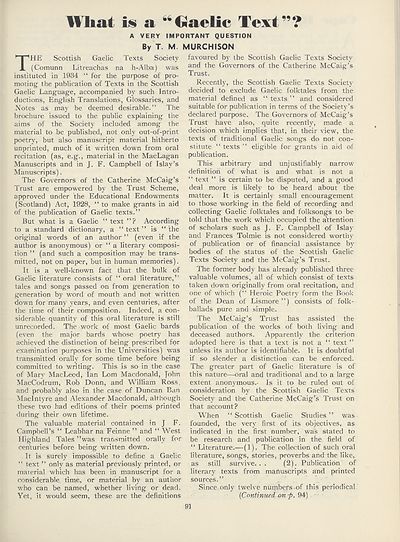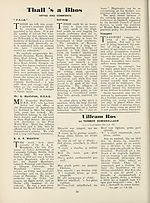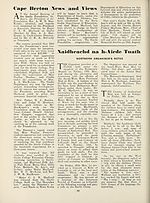An Comunn Gàidhealach Publications > Gaidheal > Volumes 44--45, January 1949--December 1950
(423) Page 91
Download files
Complete book:
Individual page:
Thumbnail gallery: Grid view | List view

What is a Gaelic Text”?
A VERY IMPORTANT QUESTION
By T. M MURCHISON
THE Scottish Gaelic Texts Society
(Comunn Litreachas na h-Alba) was
instituted in 1934 “ for the purpose of pro¬
moting the publication of Texts in the Scottish
Gaelic Language, accompanied by such Intro¬
ductions, English Translations, Glossaries, and
Notes as may be deemed desirable.” The
brochure issued to the public explaining the
aims of the Society included among the
material to be published, not only out-of-print
poetry, but also manuscript material hitherto
unprinted, much of it written down from oral
recitation (as, e.g., material in the MacLagan
Manuscripts and in J. F. Campbell of Islay’s
Manuscripts).
The Governors of the Catherine McCaig’s
Trust are empowered by the Trust Scheme,
approved under the Educational Endowments
(Scotland) Act, 1928, ‘‘ to make grants in aid
of the publication of Gaelic texts.”
But what is a Gaelic “ text ”? According
to a standard dictionary, a “ text ” is “ the
original words of an author” (even if the
author is anonymous) or ‘‘ a literary composi¬
tion ” (and such a composition may be trans¬
mitted, not on paper, but in human memories).
It is a well-known fact that the bulk of
Gaelic literature consists of ” oral literature,”
tales and songs passed on from generation to
generation by word of mouth and not written
down for many years, and even centuries, after
the time of their composition. Indeed, a con¬
siderable quantity of this oral literature is still
unrecorded. The work of most Gaelic bards
(even the major bards whose poetry has
achieved the distinction of being prescribed fpr
examination purposes in the Universities) was
transmitted orally for some time before being
committed to writing. This is so in the case
of Mary MacLeod, Ian Lorn Macdonald, John
MacCodrum, Rob Donn, and William Ross,
and probably also in the case of Duncan Ban
MacIntyre and Alexander Macdonald, although
these two had editions of their poems printed
during their own lifetime.
The valuable material contained in J F.
Campbell’s “ Leabhar na Feinne ” and “ West
Highland Tales ’’was transmitted orally for
cen'turies before being written down.
It is surely impossible to define a Gaelic
“ text ” only as material previously printed, or
material which has been in manuscript for a
considerable time, or material by an author
who can be named, whether living or dead.
Yet, it would seem, these are the definitions
favoured by the Scottish Gaelic Texts Society
and the Governors of the Catherine McCaig’s
Trust.
Recently, the Scottish Gaelic Texts Society
decided to exclude Gaelic folktales from the
material defined as ” texts ” and considered
suitable for publication in terms of the Society’s
declared purpose. The Governors of McCaig’s
Trust have also, quite recently, made a
decision which implies that, in their view, the
texts of traditional Gaelic songs do not con¬
stitute “ texts ” eligible for grants in aid of
publication.
This arbitrary and unjustifiably narrow
definition of what is and what is not a
” text ” is certain to be disputed, and a good
deal more is likely to be heard about the
matter. It is certainly small encouragement
to those working in the field of recording and
collecting Gaelic folktales and folksongs to be
told that the work which occupied the attention
of scholars such as J. F. Campbell of Islay
and Frances Tolmie is not considered worthy
of publication or of financial assistance by
bodies of the status of the Scottish Gaelic
Texts Society and the McCaig’s Trust.
The former body has already published three
valuable volumes, all of which consist of texts
taken down originally from oral recitation, and
one of which (‘‘ Heroic Poetry form the Book
of the Dean of Lismore ”) consists of folk-
ballads pure and simple.
The McCaig’s Trust has assisted the
publication of the works of both living and
deceased authors. Apparently the criterion
adopted here is that a text is not a “ text ”
unless its author is identifiable. It is doubtful
if so slender a distinction can be enforced.
The greater part of Gaelic literature is of
this nature—oral and traditional and to a large
extent anonymous.- Is it to be ruled out of
consideration by the Scottish Gaelic Texts
Society and the Catherine McCaig’s Trust on
that account?
When “ Scottish Gaelic Studies ” was
founded, the very first of its objectives, as
indicated in the first number, was stated to
be research and publication in the field of
” Literature.—(1). The collection of such oral
literature, songs, stories, proverbs and the like,
as still survive. . . (2). Publication of
literary texts from manuscripts and printed
sources.”
Since only twelve numbers-of this periodical
{Continued an -p. 94)
A VERY IMPORTANT QUESTION
By T. M MURCHISON
THE Scottish Gaelic Texts Society
(Comunn Litreachas na h-Alba) was
instituted in 1934 “ for the purpose of pro¬
moting the publication of Texts in the Scottish
Gaelic Language, accompanied by such Intro¬
ductions, English Translations, Glossaries, and
Notes as may be deemed desirable.” The
brochure issued to the public explaining the
aims of the Society included among the
material to be published, not only out-of-print
poetry, but also manuscript material hitherto
unprinted, much of it written down from oral
recitation (as, e.g., material in the MacLagan
Manuscripts and in J. F. Campbell of Islay’s
Manuscripts).
The Governors of the Catherine McCaig’s
Trust are empowered by the Trust Scheme,
approved under the Educational Endowments
(Scotland) Act, 1928, ‘‘ to make grants in aid
of the publication of Gaelic texts.”
But what is a Gaelic “ text ”? According
to a standard dictionary, a “ text ” is “ the
original words of an author” (even if the
author is anonymous) or ‘‘ a literary composi¬
tion ” (and such a composition may be trans¬
mitted, not on paper, but in human memories).
It is a well-known fact that the bulk of
Gaelic literature consists of ” oral literature,”
tales and songs passed on from generation to
generation by word of mouth and not written
down for many years, and even centuries, after
the time of their composition. Indeed, a con¬
siderable quantity of this oral literature is still
unrecorded. The work of most Gaelic bards
(even the major bards whose poetry has
achieved the distinction of being prescribed fpr
examination purposes in the Universities) was
transmitted orally for some time before being
committed to writing. This is so in the case
of Mary MacLeod, Ian Lorn Macdonald, John
MacCodrum, Rob Donn, and William Ross,
and probably also in the case of Duncan Ban
MacIntyre and Alexander Macdonald, although
these two had editions of their poems printed
during their own lifetime.
The valuable material contained in J F.
Campbell’s “ Leabhar na Feinne ” and “ West
Highland Tales ’’was transmitted orally for
cen'turies before being written down.
It is surely impossible to define a Gaelic
“ text ” only as material previously printed, or
material which has been in manuscript for a
considerable time, or material by an author
who can be named, whether living or dead.
Yet, it would seem, these are the definitions
favoured by the Scottish Gaelic Texts Society
and the Governors of the Catherine McCaig’s
Trust.
Recently, the Scottish Gaelic Texts Society
decided to exclude Gaelic folktales from the
material defined as ” texts ” and considered
suitable for publication in terms of the Society’s
declared purpose. The Governors of McCaig’s
Trust have also, quite recently, made a
decision which implies that, in their view, the
texts of traditional Gaelic songs do not con¬
stitute “ texts ” eligible for grants in aid of
publication.
This arbitrary and unjustifiably narrow
definition of what is and what is not a
” text ” is certain to be disputed, and a good
deal more is likely to be heard about the
matter. It is certainly small encouragement
to those working in the field of recording and
collecting Gaelic folktales and folksongs to be
told that the work which occupied the attention
of scholars such as J. F. Campbell of Islay
and Frances Tolmie is not considered worthy
of publication or of financial assistance by
bodies of the status of the Scottish Gaelic
Texts Society and the McCaig’s Trust.
The former body has already published three
valuable volumes, all of which consist of texts
taken down originally from oral recitation, and
one of which (‘‘ Heroic Poetry form the Book
of the Dean of Lismore ”) consists of folk-
ballads pure and simple.
The McCaig’s Trust has assisted the
publication of the works of both living and
deceased authors. Apparently the criterion
adopted here is that a text is not a “ text ”
unless its author is identifiable. It is doubtful
if so slender a distinction can be enforced.
The greater part of Gaelic literature is of
this nature—oral and traditional and to a large
extent anonymous.- Is it to be ruled out of
consideration by the Scottish Gaelic Texts
Society and the Catherine McCaig’s Trust on
that account?
When “ Scottish Gaelic Studies ” was
founded, the very first of its objectives, as
indicated in the first number, was stated to
be research and publication in the field of
” Literature.—(1). The collection of such oral
literature, songs, stories, proverbs and the like,
as still survive. . . (2). Publication of
literary texts from manuscripts and printed
sources.”
Since only twelve numbers-of this periodical
{Continued an -p. 94)
Set display mode to:
![]() Universal Viewer |
Universal Viewer | ![]() Mirador |
Large image | Transcription
Mirador |
Large image | Transcription
| An Comunn Gàidhealach > An Comunn Gàidhealach Publications > Gaidheal > Volumes 44--45, January 1949--December 1950 > (423) Page 91 |
|---|
| Permanent URL | https://digital.nls.uk/127127112 |
|---|
| Description | This contains items published by An Comunn, which are not specifically Mòd-related. It includes journals, annual reports and corporate documents, policy statements, educational resources and published plays and literature. It is arranged alphabetically by title. |
|---|
| Description | A collection of over 400 items published by An Comunn Gàidhealach, the organisation which promotes Gaelic language and culture and organises the Royal National Mòd. Dating from 1891 up to the present day, the collection includes journals and newspapers, annual reports, educational materials, national Mòd programmes, published Mòd literature and music. |
|---|---|
| Additional NLS resources: |
|

